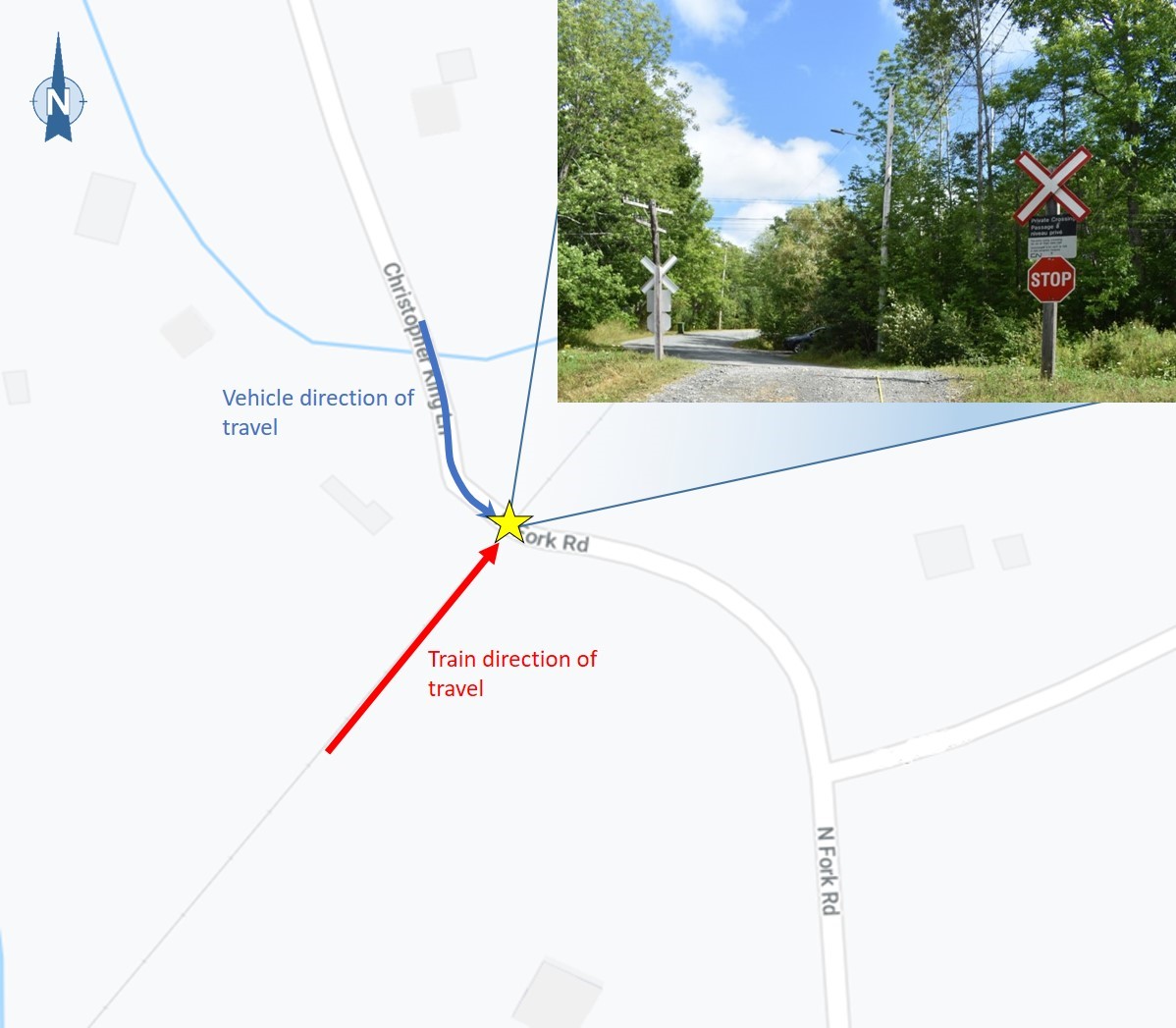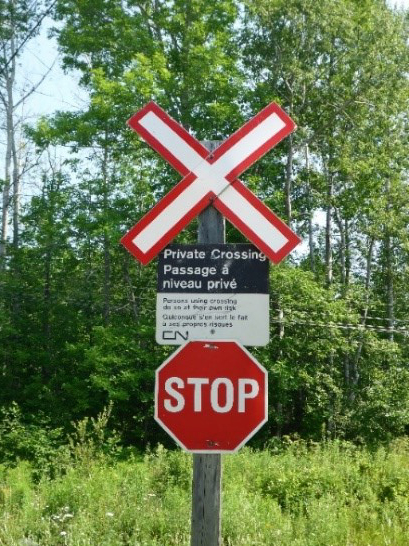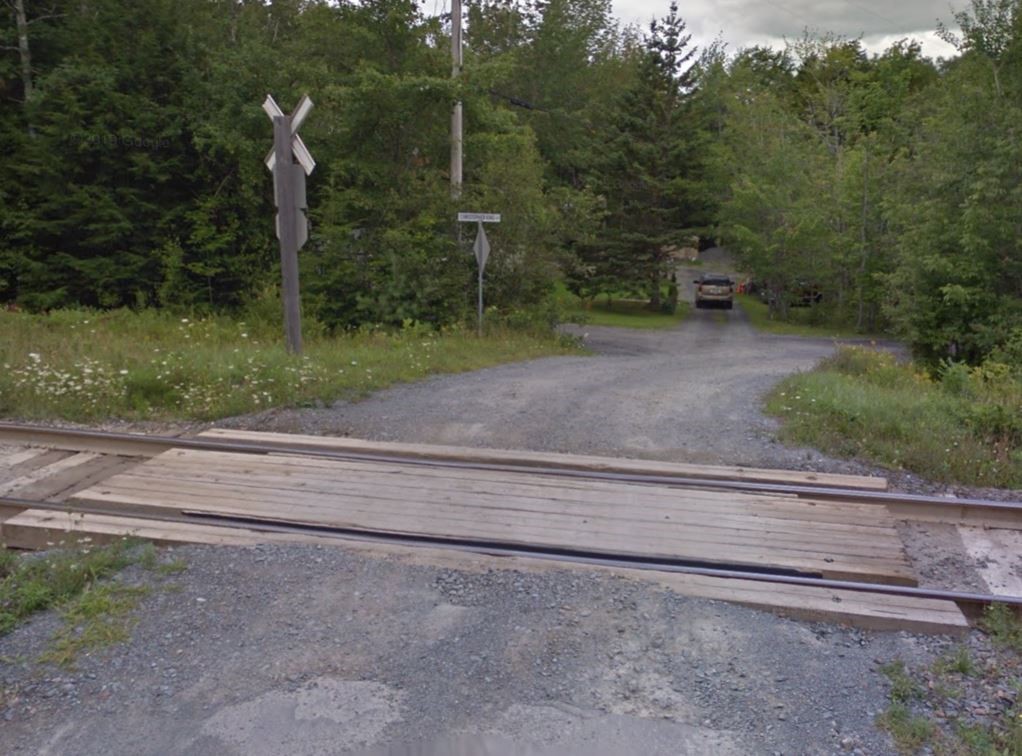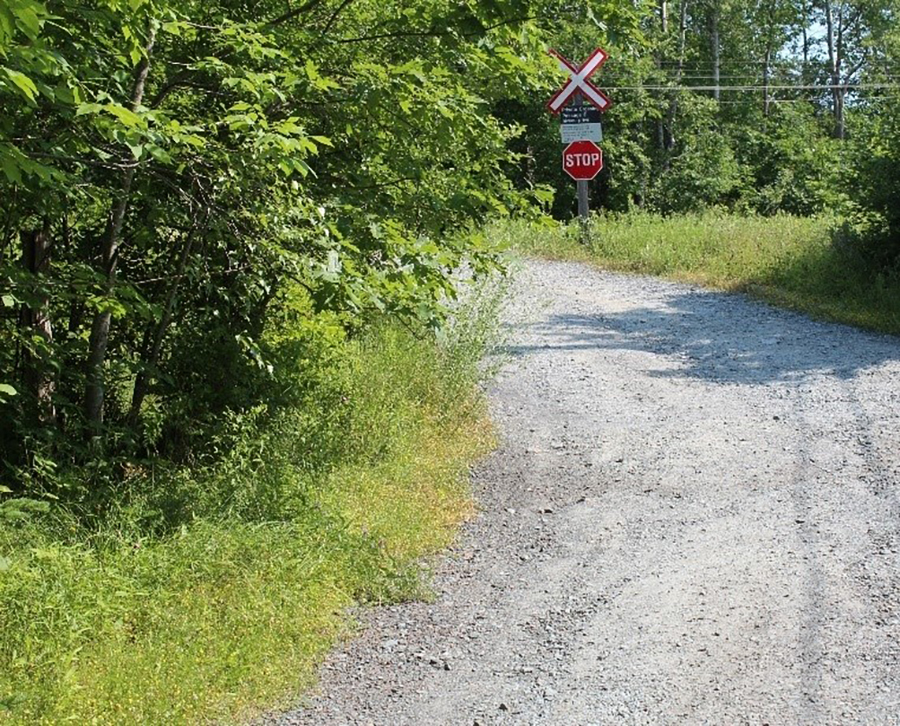Crossing accidentTrain A40711-29
Mile 27.73, Bedford Subdivision
Oakfield, Nova Scotia
The Transportation Safety Board of Canada (TSB) investigated this occurrence for the purpose of advancing transportation safety. It is not the function of the Board to assign fault or determine civil or criminal liability. This report is not created for use in the context of legal, disciplinary or other proceedings. See Ownership and use of content. Masculine pronouns and position titles may be used to signify all genders to comply with the Canadian Transportation Accident Investigation and Safety Board Act (S.C. 1989, c. 3).
The occurrence
On 29 July 2019, Canadian National Railway Company (CN) freight train A40711-29 was travelling northeast on the CN Bedford Subdivision. The train comprised 2 head-end locomotives and 25 cars, weighed approximately 1595 tons, and was about 2315 feet long. The train crew consisted of a locomotive engineer and a conductor. Both crew members were qualified for their respective positions and met rest and fitness requirements.
At approximately 1135,Footnote 1 the train approached the private crossing at Mile 27.73 in Oakfield, Nova Scotia, at a speed of 51 mph. The lead locomotive headlights were on full power and its ditch lights were activated. The locomotive horn was not activated, and there is no requirement for trains to whistle at the approach to private crossings. At about the same time, a passenger vehicle with 2 occupants travelling southward on Christopher King Lane was approaching the crossing at a speed of approximately 20 km/h (Figure 1).
Both road approaches to the crossing have a stop sign secured to the wooden post for the standard railway crossing sign (SRCS). The vehicle, with its windows closed, proceeded onto the crossing without stopping at the stop sign. At 1136:03, upon observing the vehicle, the locomotive engineer activated the head-end locomotive horn. One second later, the train collided with the vehicle at the crossing, striking the front passenger side and pushing the vehicle down an embankment where it overturned. The train brakes were placed into emergency about 2 seconds after the collision. The train came to a complete stop approximately 1 minute later, after having travelled about 1690 feet.
The vehicle driver sustained serious injuries and was airlifted to a hospital for treatment. The vehicle passenger sustained minor injuries and was transported to the local hospital by ambulance. The train crew members were not injured.
At the time of the occurrence, the weather was 27 °C, partly cloudy, with good visibility.
Track and subdivision information
The CN Bedford Subdivision is a single main track that extends from Halifax, Nova Scotia (Mile 0.0), to Truro, Nova Scotia (Mile 64.0). Train movements are controlled by the centralized traffic control system from Mile 5.0 to Mile 64.0 and are supervised by a CN rail traffic controller in Montréal, Quebec.
In the occurrence area, train traffic consisted of about 10 freight trains per day and about 6 VIA Rail Canada Inc. (VIA) passenger trains per week. The track is maintained to a Class 4 standard, in accordance with the Transport Canada (TC)–approved Rules Respecting Track Safety. The authorized track speed near the occurrence area is 55 mph for freight trains and 65 mph for passenger trains.
<em>Grade Crossings Regulations</em> and <em>Grade Crossings Standards</em>
The TC Grade Crossings Regulations (GCR) and Grade Crossings Standards (GCS), which came into force in November 2014, apply to all newly built crossings. Existing crossings must be updated to comply with selected provisions in the GCR and GCS by 28 November 2021. Both the GCR and GCS were last amended in January 2019. These amendments, which came into force in March 2019, clarify some of the provisions and make them easier to follow.
Section 6 of the GCS sets out the road geometry provisions for grade crossings and road approaches.
Concerning road approaches to private grade crossings, the GCS specify a maximum gradient of 2% within 8 m of the nearest rail and 10% for 10 m beyond.Footnote 2 Although all newly constructed private grade crossings are required to meet these standards, and existing private crossings are required to meet certain provisions of the standards, such as crossing sightlines, the maximum gradient for road approaches does not retroactively apply to existing private crossings.
The maintenance of private grade crossings is a shared responsibility between the railway and the owner of the private crossing (private authority). As stated in CN’s standard practice circulars, the railway is responsible for the maintenance of the crossing surface up to 18 inches (46 cm) beyond the outside rails. The railway is also responsible for sightlines and signage, as outlined in the GCR. The private authority, according to the GCR, must ensure compliance with the requirements of the regulations for the road approach outside the railway right-of-way.
Grade crossing protection measures
Grade crossings can be equipped with different types of protection systems. These include automated warning systemsFootnote 3 and passive signs. Although not required under the GCR, some private grade crossings are equipped with a stop sign, an SRCS, and a private crossing sign (Figure 2). Vehicles approaching such crossings are expected to perform a full stop at the crossing and to proceed only when it is safe to do so.
Private crossing at Christopher King Lane
At the private crossing (Mile 27.73), the road south of the crossing (North Fork Road) is a provincial road, while the road north of the crossing (Christopher King Lane) is a single-lane private gravel road that leads to 7 residences. Christopher King Lane traverses the railway track at approximately 90 degrees. The crossing surface is made up of wood planks. Passive warning signs (reflectorized SRCS and stop sign) are attached to a wooden post that is positioned 13.5 feet south of the centre of the crossing (Figure 3). The crossing surface and reflectorized SRCS meet TC’s applicable regulatory provisions. The speed limit for vehicles in the vicinity of the crossing is 30 km/h.
When approaching the crossing, southbound vehicles on Christopher King Lane are required to navigate a curved section of the road that is lined with trees. The road at this approach has an ascending gradient of approximately 13% within 8 m of the nearest rail (Figure 4). As this crossing is equipped with a stop sign, the sightlines along the railway right-of-way (measured from the stop position) meet TC’s regulatory requirements.
During site examination, it was noted that after southbound vehicles stop at the crossing, some vehicles had difficulty pulling away due to the presence of gravel and the road’s gradient. In the winter, the presence of snow and ice could further exacerbate this situation.
Crossing accidents
There are approximately 14 000 public and 9000 private grade crossings along over 26 000 miles of federally regulated rail lines in Canada. From 2009 to 2018, there were 1706 crossing accidents on federally regulated railways in Canada, resulting in 222 fatalities and 264 serious injuries. Of these 1706 accidents, 255 occurred at private crossings that were protected using passive warning signs. Of these 255 occurrences, there were 11 fatalities and 19 serious injuries.Footnote 4
Public awareness programs for rail safety
Railways, regulators, and law enforcement agencies participate in railway safety awareness programs. Operation Lifesaver is a not-for-profit organization (funded by the Railway Association of Canada and TC) that works with the rail industry, governments, law enforcement, labour groups, the media, and many public organizations and community groups to raise awareness about rail safety. Operation Lifesaver’s goal is to create safety-conscious attitudes toward railways, promote safe driving skills, and encourage Canadians to adhere to railway signs and warnings. Operation Lifesaver delivers safety presentations to schools, youth clubs, drivers’ associations, and other community groups to raise awareness about the hazards associated with railway tracks and trains.
In addition to supporting Operation Lifesaver, TC has a Rail Safety Improvement Program to improve safety at grade crossings and along rail lines and to increase public confidence in Canada’s rail transportation system. TC’s Rail Safety Improvement Program helps achieve this by making funding available to eligible recipients, including private crossing owners.Footnote 5 However, the majority of the applications for this funding are for public crossings.
With approximately 9000 private crossings along federally regulated rail lines in Canada,Footnote 6 it is important for railways and private crossing owners to consider the effect of roadway grade, curvature, surface, and sightlines on the ability to comply safely with crossing signage, or to consider adding grade crossing warning systems.
Previous occurrences at the Christopher King Lane crossing
Since 2012, 2 other occurrences at this crossing have been reported to the TSB:
- R12M0001 – On 23 January 2012, VIA train 14-22 struck the trailer portion of a tractor-trailer that had become stuck on the crossing. No injuries were reported. Following this occurrence, warning signs for low-body trailers were installed at the south approach to the crossing.
- R18M0032 – On 26 October 2018, CN train L51111-26 struck the front bumper of a pickup truck that had stopped too close to the crossing. No injuries were reported.
Safety message
To ensure safety at private grade crossings that are protected by passive stop signs, it is important that all motor vehicle drivers obey posted traffic signs.
In addition, the physical design of private grade crossings, including their road approaches, plays a role in enabling motorists to navigate these crossings safely.
This report concludes the Transportation Safety Board of Canada’s investigation into this occurrence. The Board authorized the release of this report on 22 January 2020. It was officially released on 07 February 2020.



